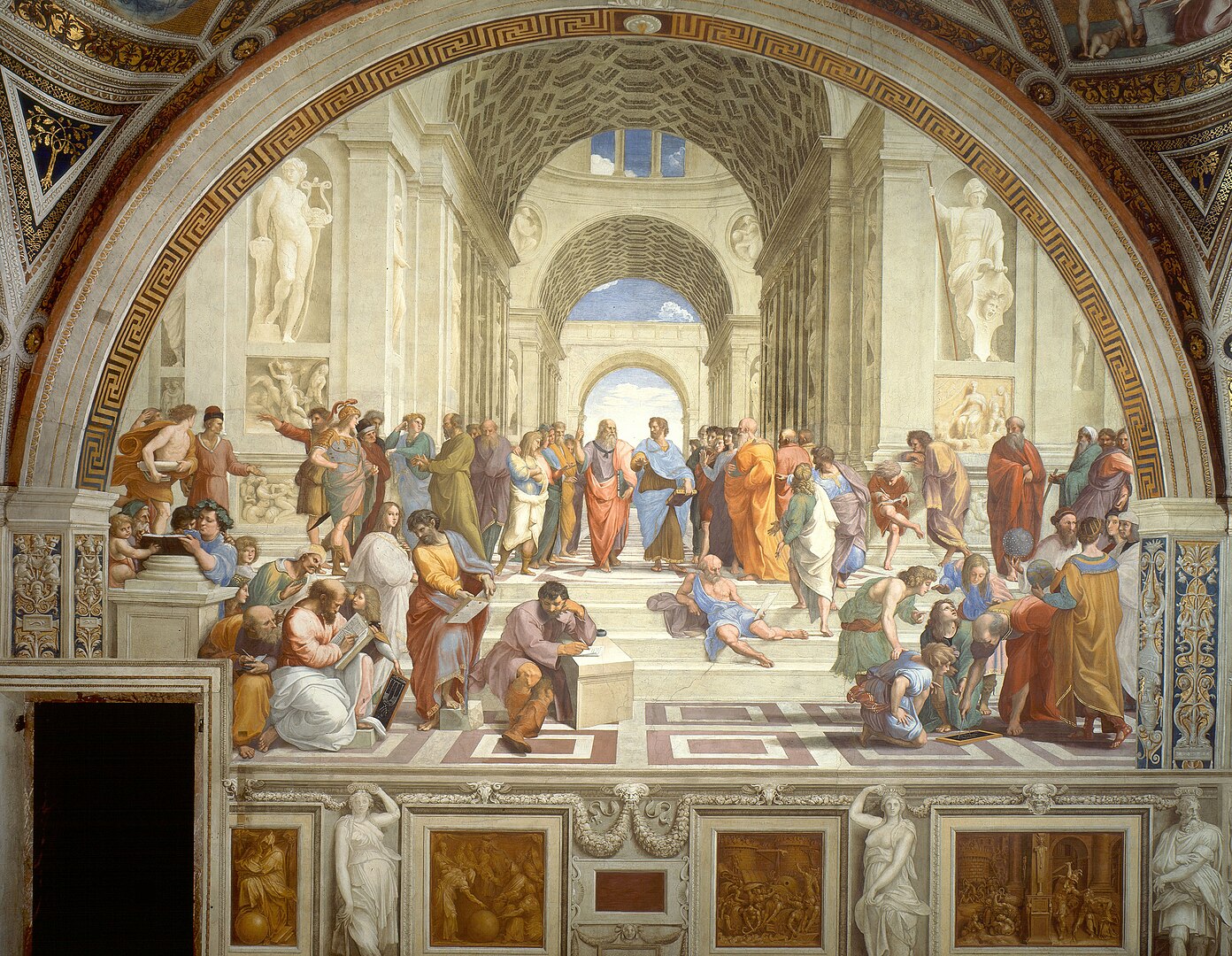
The Significance of The School of Athens Painting
One of the most celebrated frescoes of the High Renaissance, The School of Athens by Raphael is a masterpiece that encapsulates the intellectual spirit of the era. Painted between 1509 and 1511, this iconic work is located in the Stanza della Segnatura in the Vatican, a room within the Apostolic Palace. Commissioned by Pope Julius II, The School of Athens represents the pursuit of knowledge, the importance of philosophy, and the unity of intellectual thought.
Raphael masterfully brought together some of the most significant thinkers of antiquity, depicting them in a grand architectural setting that symbolizes wisdom, rationality, and classical ideals. The fresco is part of a series of paintings in the room, each representing one of the four domains of human knowledge: Theology, Law, Poetry, and Philosophy. The School of Athens specifically embodies Philosophy, celebrating human reason and the legacy of Greek thought that deeply influenced the Renaissance.
Who Is the Woman in The School of Athens?
One of the intriguing figures in the fresco is a woman dressed in white, standing among the philosophers. This figure is believed to represent Hypatia of Alexandria, a renowned mathematician, astronomer, and philosopher from the late 4th and early 5th centuries. Hypatia was one of the few female intellectuals of antiquity whose name and works have survived history, making her inclusion in Raphael’s painting highly significant.
Alternatively, some scholars suggest that this figure could represent Francesco Maria della Rovere, the nephew of Pope Julius II, disguised in female form. Others argue that she symbolizes a generic representation of wisdom or philosophy itself. Regardless of interpretation, her inclusion stands as a tribute to the intellectual contributions of women in a predominantly male-dominated historical narrative.
**The Painting Method Used in **The School of Athens
Raphael executed The School of Athens using the fresco technique, which involves applying pigment onto wet plaster. This method ensures that the colors become an integral part of the wall, creating a durable and vibrant image. Fresco painting requires meticulous planning and execution, as artists must work swiftly before the plaster dries.
Raphael’s mastery in fresco technique is evident in the fluidity of the figures, the clarity of composition, and the brilliant use of color to create depth and movement. He employed preparatory sketches, known as cartoons, to outline the composition before transferring it onto the plaster. This meticulous planning allowed for precise execution, resulting in a harmonious and lifelike scene.
**The Two Main Figures in **The School of Athens
At the center of the fresco stand the two most prominent figures of ancient philosophy: Plato and Aristotle. They serve as the focal point of the composition, embodying two distinct yet complementary schools of thought.
Plato, depicted as an older man with a long beard, points skyward with his right hand. He holds a copy of his work Timaeus, which explores the nature of reality and the cosmos. His upward gesture symbolizes his belief in the realm of ideal forms, a philosophy that suggests that true knowledge comes from understanding abstract, eternal truths rather than physical reality.
Aristotle, standing beside him, extends his right hand horizontally, emphasizing empirical observation and grounded reasoning. He holds his Nicomachean Ethics, a treatise on human virtue and morality. His stance reflects his emphasis on experience and the tangible world, contrasting with Plato’s idealism.
Together, Plato and Aristotle represent the duality of philosophical inquiry, metaphysical idealism versus empirical realism, both of which have profoundly influenced Western thought.
**Perspective Used in **The School of Athens
Raphael employed linear perspective to create depth and spatial harmony in The School of Athens. The fresco follows a one-point perspective system, with the vanishing point located at the exact center, between Plato and Aristotle. This technique directs the viewer’s eye naturally toward the central figures, reinforcing their philosophical significance.
To achieve this effect, Raphael structured the composition using a series of converging lines that lead toward the vanishing point. The grand archway and the receding coffered ceiling further enhance the illusion of three-dimensional space, making the scene appear dynamic and immersive. By employing perspective so skillfully, Raphael elevated the fresco beyond mere representation, transforming it into an intellectual and visual experience.
Where Is The School of Athens Located Today?
Today, The School of Athens remains in its original location in the Stanza della Segnatura within the Vatican Museums. The room was originally intended as Pope Julius II’s private library and study, making it a fitting setting for a fresco that celebrates philosophy and knowledge.
The Vatican Museums continue to attract millions of visitors each year, offering them the chance to witness Raphael’s genius up close. The School of Athens is widely regarded as one of the greatest achievements of Renaissance art, embodying the era’s ideals of classical learning, artistic perfection, and intellectual revival.
The School of Athens is more than just a painting; it is a timeless tribute to human intellect, creativity, and the pursuit of truth. Raphael’s use of composition, perspective, and symbolism ensures that this fresco remains an enduring masterpiece. Whether one admires it for its artistic brilliance or its philosophical depth, The School of Athens stands as a testament to the power of knowledge and the lasting legacy of the great thinkers of antiquity.




